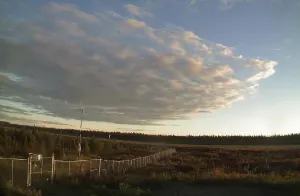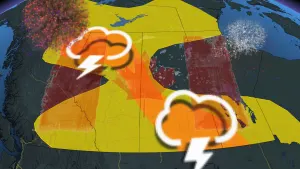
Quirky warning sign used by the 'acrobats of the skunk world'
The interesting technique has earned these animals a well-deserved label: The 'acrobats of the skunk world.'
Skunks have an effective defence mechanism to ward off potential threats, but some of them have a unique way of warning them before they unleash it.
All species of skunk generate a nasty-smelling spray to caution predators, but only the spotted skunks have a visually impressive way of deploying it: A handstand on their front legs as additional advance warning.
The interesting technique has earned spotted skunks a well-deserved label.
SEE ALSO: Watch for these skunk warning signs to avoid getting sprayed
“Spotted skunks are sometimes called the acrobats of the skunk world,” said Adam Ferguson, the Negaunee collections manager of mammals at The Field Museum of Natural History, in a news release.
As their moniker suggests, they contain spots instead of stripes, although technically they’re just "broken stripes," The Field Museum says.
It turns out the spotted skunk has a bigger population than originally thought. Cited in a new paper in Molecular Phylogenetics and Evolution, researchers examined skunk DNA (deoxyribonucleic acid) and discovered there aren’t just four species of spotted skunk they previously believed existed -- there are seven.

Spotted skunk doing a handstand on its front legs as an extra warning sign. (Jerry W. Dragoo).
“North America is one of the most-studied continents in terms of mammals, and carnivores are one of the most-studied groups,” said Ferguson, one of the paper’s authors. “Everyone thinks we know everything about mammalian carnivore systematics, so being able to redraw the skunk family tree is very exciting.”
NEW SPECIES' UNCOVERED, POPULATIONS IN NORTH AMERICA
Among the new species that have been confirmed are the Yucatan spotted skunk, squirrel-sized and found only in the Yucatan Peninsula, and the Plains spotted skunk. The latter has seen its population dwindling for the past century, with conservationists making efforts to get it classified as an endangered subspecies.
“If a subspecies is in trouble, there’s sometimes less emphasis on protecting it because it's not as distinct an evolutionary lineage as a species,” said Ferguson.
“We’ve shown that the Plains spotted skunks are distinct at the species level, which means they've been evolving independently of the other skunks for a long time. Once something has a species name, it's easier to conserve and protect.”
The DNA sequences that were compared revealed that some of the skunks were considered the same species previously were actually considerably different. The genetic contrasts then prompted researchers to reorganize some of the skunks and revive several species names that haven't been utilized in centuries.
“I was able to extract DNA from century-old museum samples and it was really exciting to see who those individuals were related to. It turns out that one of those was a currently unrecognized, endemic species in the Yucatan," said Molly McDonough, a biology professor at Chicago State University, research associate at The Field Museum and the paper’s first author, in the news release.
Their population is spread throughout North America, but spotted skunks have yet to find residence in urban areas on the scale of their striped cousins.
Though the number of spotted skunk species was dwindled down to four prior to the new research, Ferguson thinks there may be more because of insufficient genetic sequence data from "morphologically distinct or geographically isolated populations of this wide-ranging genus," he said.
“We figured there had to be some surprises when it came to spotted skunk diversity, because the genus as a whole had never been properly analyzed using genetic data,” said Ferguson.
Thumbnail courtesy of Jerry W. Dragoo.
Follow Nathan Howes on Twitter.










